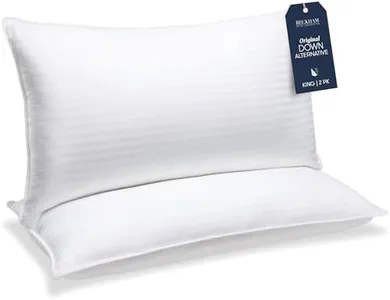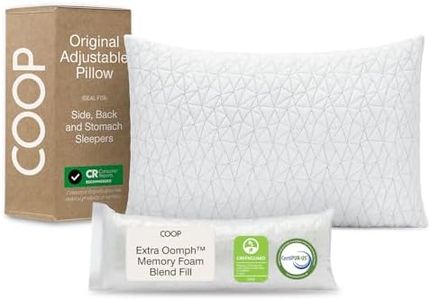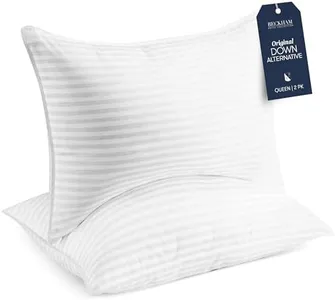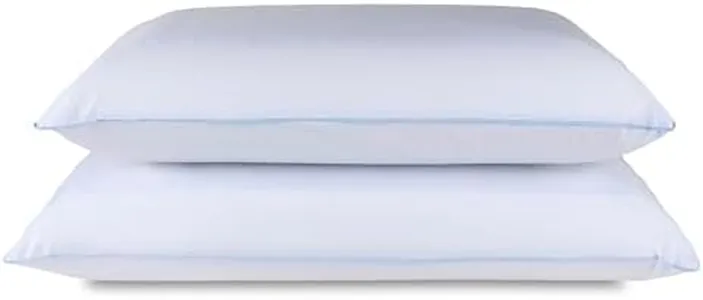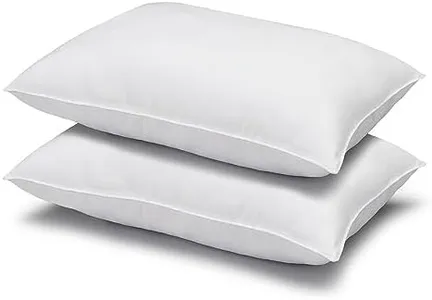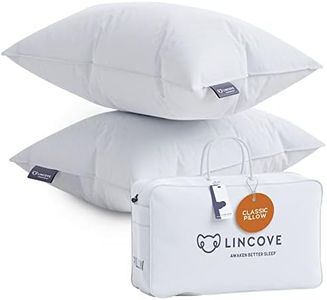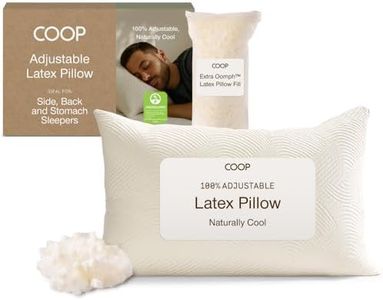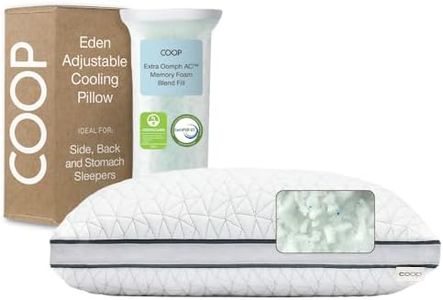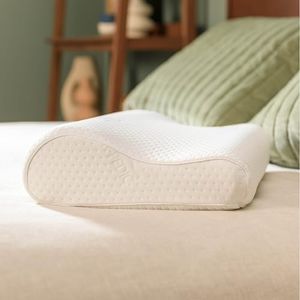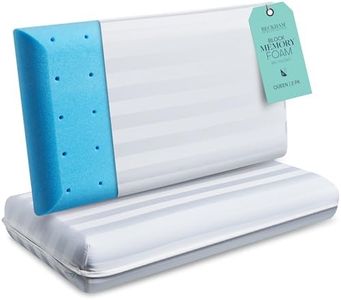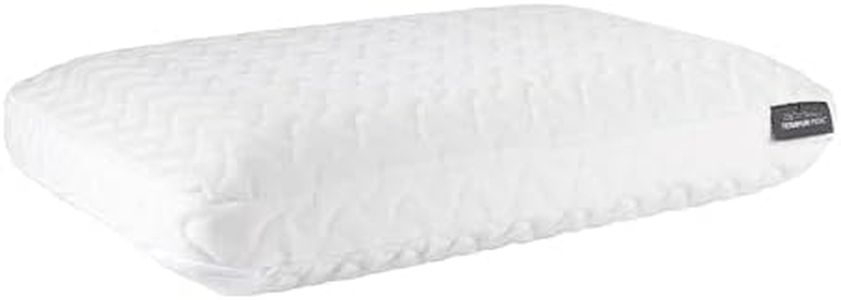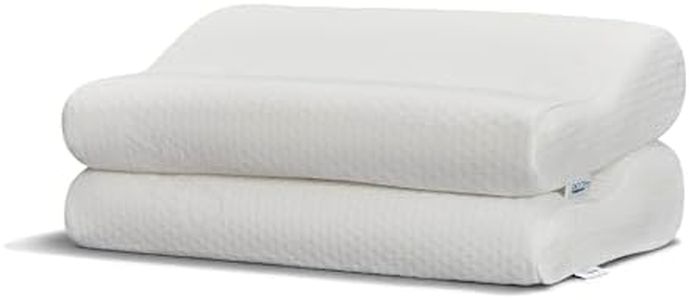10 Best Hypoallergenic Pillows 2025 in the United States
Our technology thoroughly searches through the online shopping world, reviewing hundreds of sites. We then process and analyze this information, updating in real-time to bring you the latest top-rated products. This way, you always get the best and most current options available.

Our Top Picks
Winner
Beckham Hotel Collection Bed Pillows King Size Set of 2 - Down Alternative Pillow for Back, Stomach or Side Sleepers
Most important from
256250 reviews
The Beckham Hotel Collection Bed Pillows are a solid choice for those seeking hypoallergenic options, especially for back, side, or stomach sleepers. Made with a 250 thread count cotton cover and filled with 100% polyester, these pillows offer a plush feel that many users appreciate. Their hypoallergenic material makes them suitable for allergy sufferers, which is a significant strength in this category. Additionally, the pillows are designed with breathability in mind, making them ideal for individuals who tend to overheat during the night or experience night sweats. The cooling feature is a notable advantage, providing comfort across different sleep positions.
Ease of maintenance is another highlight; they are machine washable and tumble dry friendly, which simplifies cleaning compared to some other pillow types, like memory foam. This practical feature can be particularly appealing to busy individuals or families.
If you're looking for comfortable, hypoallergenic pillows that are easy to maintain and suitable for various sleep positions, the Beckham Hotel Collection pillows are worth considering. Just keep in mind that if you prefer a firmer pillow, you might want to explore other options.
Most important from
256250 reviews
Coop Home Goods Original Adjustable Pillow, King Size Bed Pillows for Sleeping, Cross Cut Memory Foam Pillows - Medium Firm Back, Stomach and Side Sleeper Pillow, CertiPUR-US/GREENGUARD Gold
Most important from
64517 reviews
The Coop Home Goods Original Adjustable Pillow is designed to suit a wide range of sleepers—whether you sleep on your back, side, or stomach—thanks to its fully adjustable fill. You get to add or remove the shredded memory foam and microfiber blend to find the firmness and loft that feel just right for you. This makes it a strong option if you’re unsure about what pillow firmness you prefer or if you want to customize support over time.
The cover uses a soft and breathable fabric made from a mix of polyester and rayon derived from bamboo, which helps keep the pillow cool and comfortable overnight. Its breathability and the ability to wash the cover and inner pillow separately make it easier to maintain hygiene, which is important for allergy sufferers. The pillow is also certified CertiPUR-US and GREENGUARD Gold, meaning it’s made without harmful chemicals, supporting a healthier sleep environment.
A potential downside is that since the memory foam fill is cross-cut and shredded rather than solid foam, it might feel less traditional or less supportive for some people used to a firm, flat memory foam pillow. Also, the foam can feel firmer in cooler rooms, so you may need to adjust the fill accordingly. The pillow’s adjustability and breathable materials provide a versatile choice that meets hypoallergenic needs while offering personalized comfort and easy care.
Most important from
64517 reviews
Beckham Hotel Collection Bed Pillows Standard/Queen Size Set of 2 - Original Soft Down Alternative Pillow for Sleeping - Soft Support for Back, Stomach or Side Sleepers
Most important from
256250 reviews
The Beckham Hotel Collection Bed Pillows offer a comfortable sleep experience with their plush down alternative filling, making them suitable for various sleeping positions, including back, stomach, and side sleepers. The 250 thread count cotton cover adds a soft touch while also contributing to breathability, which is beneficial for those who tend to overheat or suffer from night sweats. Additionally, the pillows are OEKO-TEX Standard Certified, which assures safety and environmental considerations in their production, appealing to those concerned about health and eco-friendliness.
These pillows are easy to maintain, as they can be machine washed and dried, unlike memory foam pillows that often require more delicate care. The no shift design helps them retain their shape, offering consistent neck support for most sleepers, which is crucial for reducing neck pain. However, their plush firmness might not provide adequate support for those who prefer a firmer pillow.
As hypoallergenic pillows, they present a great alternative for those allergic to natural down, ensuring a restful sleep without allergy concerns. However, their breathability, while beneficial, might not be as effective for extremely hot sleepers, and the relatively low loft might not suit those who prefer a highly elevated head position. They serve as a good fit for anyone seeking a plush, breathable, and hypoallergenic pillow that's easy to care for. Potential buyers should consider their personal firmness and loft preferences to ensure they meet their specific comfort needs.
Most important from
256250 reviews
Buying Guide for the Best Hypoallergenic Pillows
Choosing the right hypoallergenic pillow can significantly improve your sleep quality and overall health, especially if you suffer from allergies. Hypoallergenic pillows are designed to minimize the presence of allergens such as dust mites, mold, and pet dander. When selecting a hypoallergenic pillow, it's important to consider several key specifications to ensure you find the best fit for your needs.FAQ
Most Popular Categories Right Now


